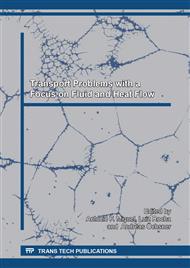p.124
p.133
p.140
p.149
p.157
p.166
p.171
p.181
p.189
Nonlinear Behaviour of Mass Transfer Mechanisms in Solvent Oil Recovery
Abstract:
Literature has indicated that, experimentally, solvent fronts in hybrid thermal solvent recovery processes progress more rapidly than what can be predicted using current approximations and more rapidly than thermal processes alone [1]. The equations that govern thermal multiphase flow through porous media are extremely complex and it is very difficult to decouple the contribution of the mass transfer mechanisms from the thermal effects. This paper explores the behavior of the mass transfer mechanisms in these processes through an examination of the nonlinear one-dimensional advection diffusion/dispersion (ADD) equation using finite difference methods. Earlier work [2] indicated that the linear ADD equation, using physically estimated parameters for diffusion and dispersion coefficients obtained from the literature, could not account for the solvent front progression rate predicted by Edmunds [3]. The results in this preliminary study indicate that the nonlinear effects are important in predicting the progression of a solvent front using the one dimensional ADD equation. The shapes and rate of propagation of the concentration profiles are influenced by both velocity and diffusion functionality. These results are more consistent with the solvent front propagation rate predicted by Edmunds [3]. These results also suggest that including nonlinear effects in traditional reservoir simulation software may be necessary in the modeling of solvent processes. Further work is needed to explore and understand the influence of the velocity and diffusion functionality necessary to mimic the behaviour observed in thermal solvent recovery processes and to further increase the understanding of their impact on solvent front propagation.
Info:
Periodical:
Pages:
181-188
Citation:
Online since:
November 2017
Authors:
Price:
Сopyright:
© 2017 Trans Tech Publications Ltd. All Rights Reserved
Share:
Citation:


